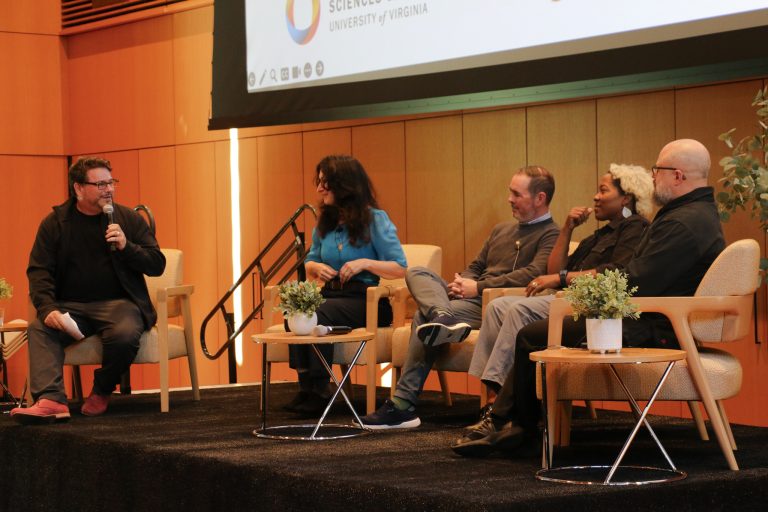JCS: You work at this very interesting intersection between a variety of things: pain management, health, neuroscience, psychedelics research, phantom limb syndrome, but also, contemplation. How did you get to this point? Either in your training, in the research that you do, or just in your personal life—how did you get into this kind of work?
FZ: I’ve always been fascinated by changes in consciousness and if we could tap into what happens after we die—the great mystery. I’ve always felt that the mind—or the brain, which is the organ of the mind—can be kind of a bridge to helping us understand in this life what happens in the next one, if there is a next one. And we are not close. I was trained as an experimental psychologist. As an undergrad twenty-five years ago, I started studying shamatha, but wanted to study these contemplative practices using a more quantitative and objective perspective. During this time period, it felt like every other kid in primary school was being prescribed Ritalin and commercials were advertising it right and left. I found it kind of appalling. I wanted to know: Can we self-regulate our consciousness, our experiences, to manifest wellbeing, to manifest greater understanding? At that time, we didn’t really study meditation as a science . . . at least I wasn’t exposed to the science of meditation. When I was introduced to so-called contemplative neuroscience, the majority of data were from meditators that were being plucked out of caves on top of mountains in Asia. I found it to be incredibly impressive and invaluable to our appreciation of the human condition—the capacity, the seemingly limitless capacity of the human condition. But I didn’t find it to be translatable to the average Joe or those kids that were popping Ritalin for whatever reason.
I became a bit obsessed with finding ways that we could apply mindfulness or mind-body approaches to the everyday person. And how the effects and biology differed from contemplative monks. As I traveled the world—Thailand, Japan, India—I’d see monks who would walk around as, indeed, religious deities would. Yet, they are relatively unemployed, celibate, and live in monastic lifestyles—which is wonderful in so many ways, and there’s pain there, of course. But I was also inspired to appreciate how we can deduce the application of mindfulness meditation from such monks to our wellbeing. Monks are superheroes to me, but their suffering may be different to, let’s say, a single mom working two jobs who doesn’t see her kids and is stressed out of her mind, who perhaps is going to go to some form of escapism in the context of drugs or alcohol or whatnot. So, this is where I learned the value of translating the experience of mindfulness in a user-friendly fashion.
As an undergrad I started studying the practice of brief bouts of meditation training on anxiety and depression. I received a Master’s degree in Cognitive Science and a Master’s degree in Liberal Studies with a focus on Western and Eastern philosophy. I had no idea which path I wanted to take.
It was then that there was the advent of functional MRI that allowed us to identify biological substrates of changes in consciousness. This was a game changer. All my friends are philosophers and we would sit around the table, stay up all night long, and debate. In the morning, there were rarely any definitive answers. The debate—the means of getting to said lack of conclusion—was so fun, and so enriching. But it wasn’t enough. I needed answers. Psychological assessments were too subjective. Biology, and understanding the neural mechanisms of consciousness, was the way forward for me.
In graduate school I became fascinated with how we could use the subjective experience of pain to disentangle the dynamic dimensions of consciousness. We started to study the interaction between shamatha practices, vipassana practices, and introducing noxious stimulation, combining those while we scanned people’s brains. That started to open up a world. In that, we were seeing the way in which mindfulness was attenuating the subjective experience of pain by engaging neural processes that we have yet to identify. They were novel. They were unique. What they showed over and over was that when we reduce the influence of the ego, or what we call egocentric appraisals. The brain processes supporting mindfulness meditation were remarkably consistent with what contemplatives have been stating for thousands of years—that was affirming and I was hooked. I earned a PhD in Experimental Psychology and followed that with an intense and highly rigorous postdoctoral fellowship learning functional MRI with Bob Coghill.
My work reflects my lack of satisfaction with not being able to come up with an answer, my fascination and obsession with consciousness and the brain, and the fact that we started to make some pretty cool discoveries. We played with the idea that mindfulness meditation may engage biological mechanisms supporting placebo. I mean, if a meditating practitioner is dedicating fourteen hours a day to practice, sitting on a cold slab of concrete, focusing on the breath with your master hitting you on the back of the neck with a bamboo stick, you’d better start believing that the s**t works! It was unclear if meditation is a placebo. What we found was that mindfulness is very different from a placebo. Every step of the way our data indicated that mindfulness meditation is very unique in the way it reduces pain, in particular, how it enhances wellbeing by reducing the influence of the self. That this is anatta—that your experiences are not you—is one of the central premises. It was so cool to see that the biology reveals and reflects in a remarkably consistent fashion what contemplatives have been saying for 4,500 years, and beyond.
Can we self-regulate our consciousness, our experiences, to manifest wellbeing, to manifest greater understanding?
JCS: I really love this aspect of your story—that you’re coming at it from such different places. That’s how you get to the real answer that you were searching for, right? Understanding the subjective, historical, as well as objective, neurological components. I can start to hear the answer to this question already, but, what’s at stake with your research, with the intersection of these two disciplines? What kind of people or communities are you hoping to impact with this?
FZ: Several. There’s a clinical aspect of it, as we’re in the midst of an opiate epidemic in this country. There is no cure for chronic pain. There are so many dimensions of treatment-resistant depression and suffering within this country. So, there’s a clinical, existential component to this—that the practice, through unveiling evidence, could alleviate suffering. I think the renaissance of mindfulness we’re seeing is really a reflection of the evidence that has been arising. Contemplatives have been postulating and stating over and over: “This is helping us. This is alleviating suffering.” But again, they could just be zealots and/or implicitly biased. With the addition of hard-nosed evidence, I think it can be different.
Another intention is to understand what these techniques are doing to us, to our biology—and by doing so, we might be able to refine the practice to target the biological substrates that lead to improvements in wellbeing. For instance, we developed this technique called sham mindfulness meditation, in which we lead people to think they’re practicing mindfulness, but they’re just taking deep, slow breaths, which is a form of meditation. Well, we found that technique is incredibly powerful. Mindfulness sometimes is more effective than that technique, and sometimes it’s not. And that technique—we don’t call it sham anymore, because it’s not. That technique is so much easier to practice. For somebody that has chronic fatigue syndrome, or multiple sclerosis, something where there’s a cognitively debilitating component of their disease, the practice of mindfulness can kind of get in the way. By finding precision meditation technique, if you will—by using the biology to inform that process, we can start to tailor different practices to different people. But it must serve the intersection between the subjective and objective. It must be performed with the highest standards, rigor and incorporate interdisciplinary perspectives.
JCS: You’ve started to circle around this, but what is the real synergy? Why do we need this interdisciplinary approach to tackle these questions?
FZ: That’s a great question. Need is a strong word, but I find that our intention for understanding truth is incomplete without considering the humanities, clinical sciences, medicine, neuroscience—and then our community dwellers, our actual stakeholders whom we serve, the people. We must listen to everyone, and we must do it in a careful fashion—in a way where we can start to integrate story with biology, and what could be happening in the brain. For instance, there’s a network in the brain called the default mode network. This is the network of the brain that corresponds to self-referential processing, subjective value, and ownership of experience. Mindfulness reliably deactivates this network. We run regression models, and what we see is that the more that it deactivates, the greater the pain relief, the greater the enhancement of wellbeing. It’s like we’re getting out of our own way.
JCS: Does that help you to understand what the next steps are in creating new forms of, as you said, precision meditation?
FZ: Absolutely, yes! We are, at least in our lab, starting to use techniques that are novel; we’re creating Meditation-Based Interventions, that are derived from our data and derived from evidence. We demonstrate what is more efficacious in, let’s say, a chronic low back pain patient versus a healthy person versus someone that has phantom limb pain or depression. Today I’m giving a talk on the work we did with victims of gun violence—parents that lost their child to a school shooting. Their grieving process is different than, say, grieving for someone who was lost to cancer. Their child was ripped away from them in one of the safest environments—a classroom. For the parents, healing is a form of not remembering their child, so they don’t want to heal. They want to continue in the field of pain as a form of honoring their child. What mindfulness can do is teach them how to skillfully grieve, how to be with that pain in a way that doesn’t impact their health. When they close their eyes, they relive the loss of their child. When they were hurt, when they found out that their child was killed, they hyperventilated. So, the breath is a source of the suffering. You must tailor the meditation training in a way that doesn’t trigger those until later. You must work your way up. One size can’t fit all. We learned that the hard way.
JCS: It reminds me of the Buddhist idea of skillful means: that, for every person, there are different approaches based on their individual context. The kind of work you’re doing, and the attention to individual or community experience and being empathic with that, I think is a beautiful way to approach these expert communities. I’m curious, if we zoom out or look into the future a little bit, where do you want to see this intersection between scientific approaches and contemplative understanding go, either in your own work or at large?
FZ: I think that mindful practice is analogous to physical training. For example, you can lift weights to make your biceps stronger, and over time you’re going to say, “I feel stronger.” But guess what, I can see your muscles get bigger too. With mental practice, we need different technology. I can hear your self-report: “I feel clear, less emotionally reactive, more present centered, more compassionate.” I also want biological evidence. The brain can show us that the biceps are getting stronger but our work has not explicitly demonstrated this in the cleanest fashion. What I want to do is scan the brains of people who have never meditated and teach them mindful practice for a lifetime. I want to show the brain’s biceps growing, if that is exactly what happens. How does the brain change as a function of our change in consciousness? How can we map that out? It would be a lifetime project. That would be my dream project.
I also want us to start to integrate more Asian philosophy with Western science at the level of elementary school children. This is very common in Asia. We also see a much more compassionate society, a less selfish society. It’s antithetical to capitalism. So, we have a lot of barriers to overcome. I think it’s time for us to implement and apply what we’ve learned. Then, we must strip out the Buddhism. Because, for example, when I first started this work, twenty-something years ago, telling folks that this was a spiritual Buddhist practice was a massive barrier to people. Dozens of participants left interventions because the change in the way they felt was not attributable to their already-existing religion. That was a form of heresy to them. So, there are certain modifications that we would have to make. Call it mental training; perhaps don’t call it meditation.
I think implementation is happening in more places. We just founded a new society, the International Society for Contemplative Research (ISCR). We took the baton from the Mind & Life Institute and are now focused on making this interdisciplinary approach shine. I think more initiatives like that, where we emphasize and focus on integrating different perspectives, is the way forward. Just like you said: it’s skillful means. We must be skillful about it. We must hold compassion in that space.
I think that mindful practice is analogous to physical training.
JCS: What are some resources for our readers to help think about this intersection between contemplation and science?
FZ: The International Symposium for Contemplative Research; we have a lot of resources on our website, and it’s growing. We have workshops and talks and symposia that are user-friendly delineations, because we must be compassionate in the way that we describe these results. We don’t use jargon. If you want the jargon, read the papers. We describe and present our work so that everyone in that room can understand it. That doesn’t mean that we dumb it down, it means that we’re all painting on the same canvas. That’s critical. The Mind & Life Institute has the Summer Research Institute, which is a wonderful convergence of Western science and Asian practice traditions. One of my favorite books is by James Austin called Zen and the Brain. It’s insane, it’s just such a game-changer.
JCS: That’s what we’re trying to do at the Journal of Contemplative Studies, too. I love this metaphor you used—how do we all paint on the same canvas? We take this in-depth scholarship and bring it together for each other to understand, but also for a larger public to understand, and be able to use and think with. It’s so important. Thank you for this conversation. It was a joy.
FZ: Thank you. This was fun.






